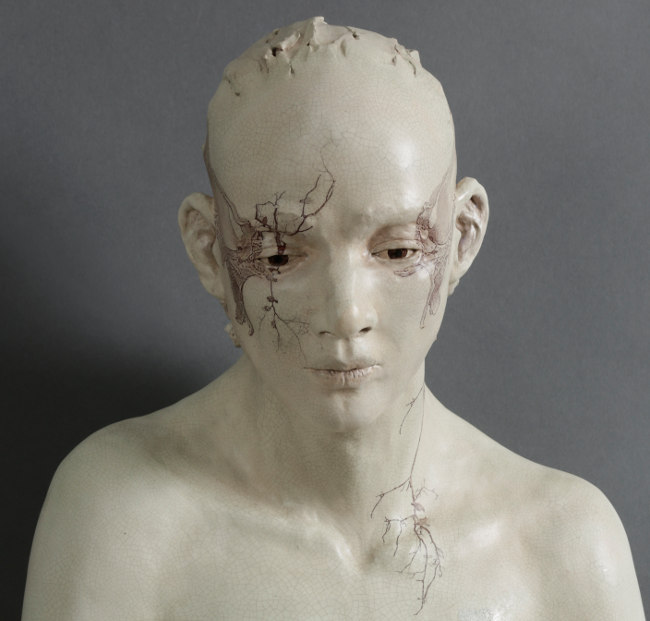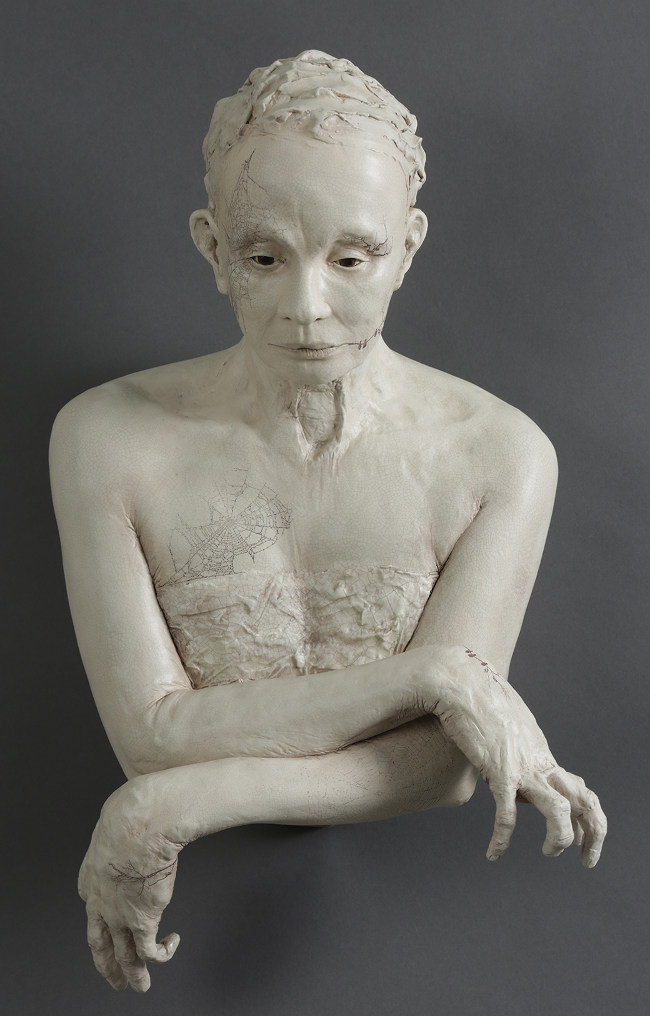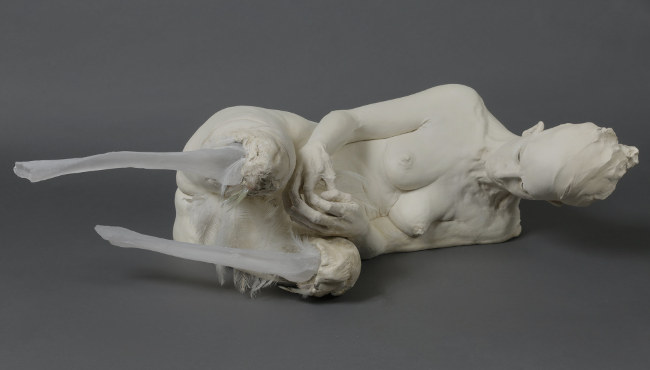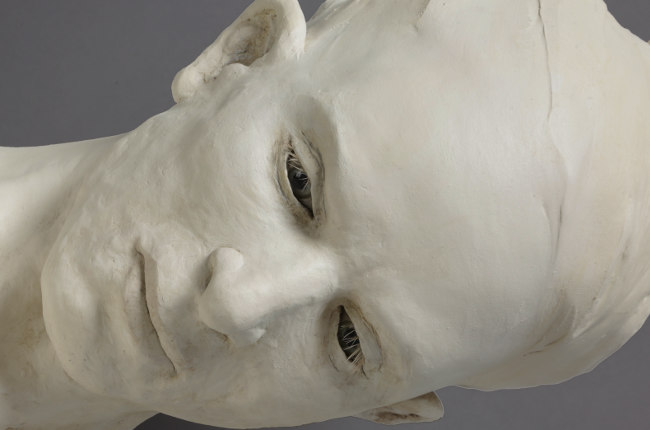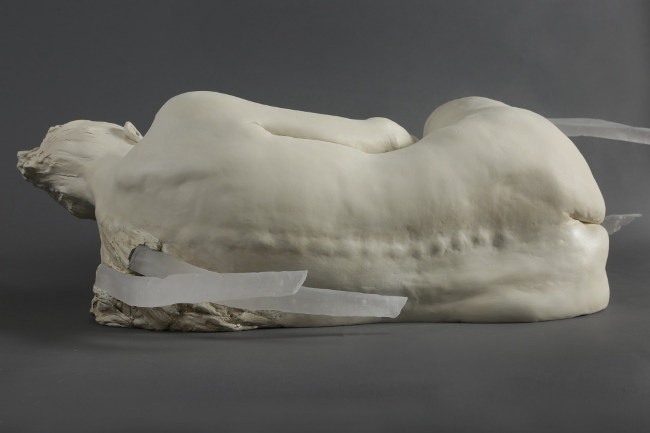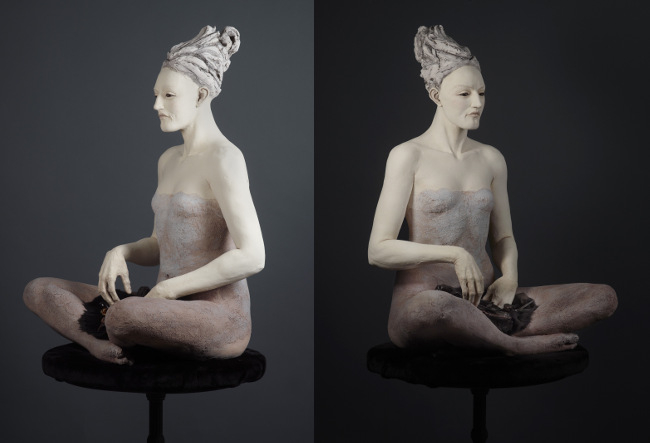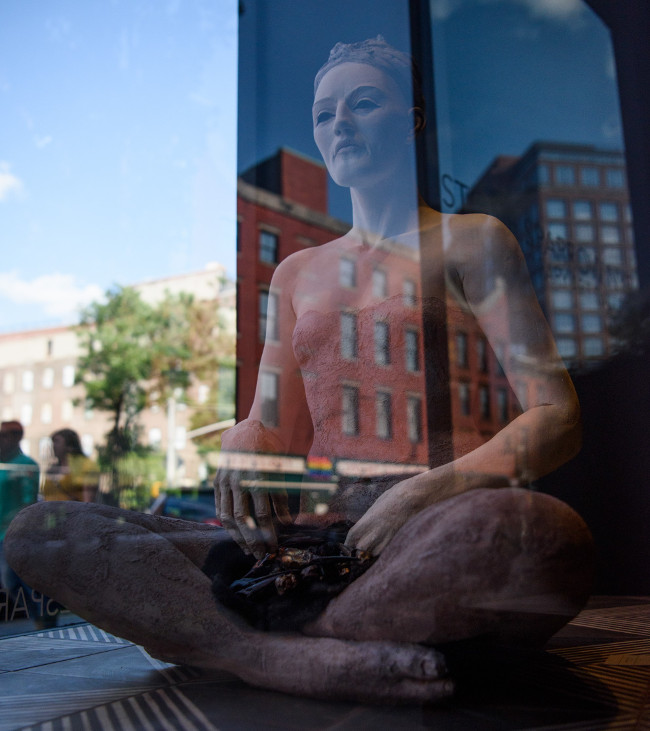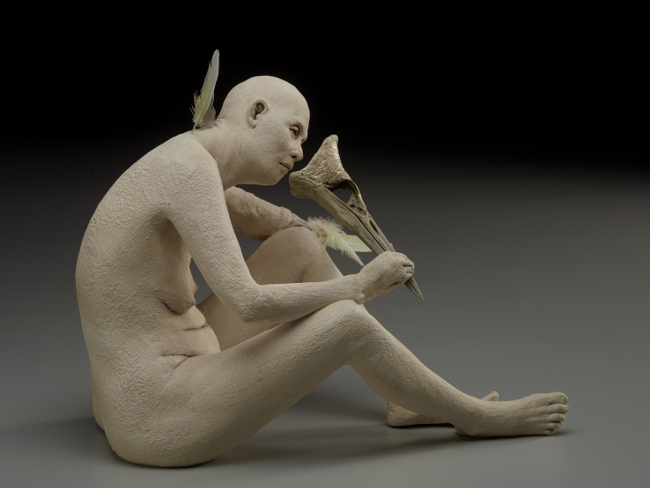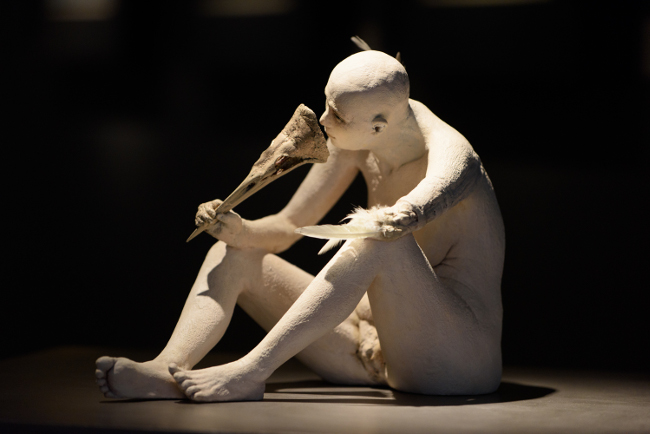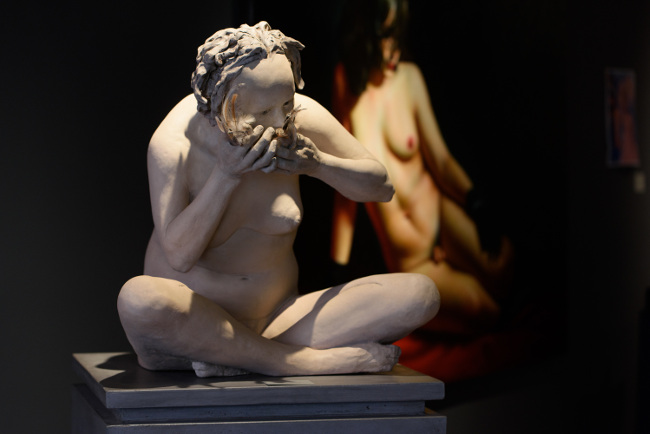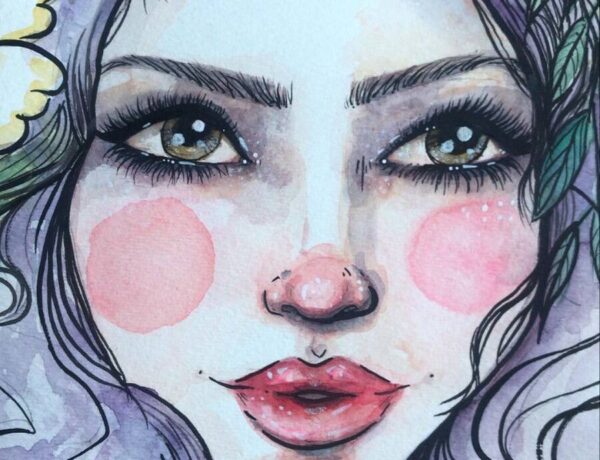Susannah Zucker’s sculptures delve into the depths of human anatomy, not only focusing the everyday physique but incorporating the vast realms of physical trauma which we can endure. Having experienced a physical trauma herself, she also shares the stories of others while encouraging us, the viewer, to think about the many realities which can exist for the human body.
And Susannah Zucker’s works aren’t without their darkly surreal charm. Her sculptures even celebrate forms of transmutation, merging with animal parts to abstractly explore the depths of adaptation which we humans are capable of in the face of adversity. Smooth, polished skin exists against deep cracks and rough lumps; Susannah’s works are a beautiful juxtaposition, timeless and unafraid to make us think about the fragility of the human body.
Susannah Zucker. Photo by Matt Rose.
Interview with Susannah Zucker
Can you tell me more about the pieces you created for your recent exhibition “On Humanity: Fragile Connections” at Stone Sparrow NYC?
I really enjoyed making the three wall sculptures called Morning, Afternoon and Evening. They incorporate photo prints as part of the surface design. Playing with photographic imagery on the body is one of the most exciting things I have experienced with my work, and it still feels new and full of promise. I love the way a tree branch can read as nervous tissue or blood vessels when placed on the skin in a particular way. Such an eerie thing to behold nature echoing our anatomical structures. I am completely fascinated!
Did you find that creating the sculptures for the show unearthed new thought pathways or emotions within you?
I think so. Marina Eliasi at Stone Sparrow NYC has been so encouraging and she let me know when she first contacted me that she prefers my broken limb and bird themed, darker works. This kind of feedback is rare, in my experience, and it frees me to make the work I am most interested in moving forward. I can dream differently as I develop the new ideas and it feels wonderful!
How long did it take you to create the sculptures shown at Stone Sparrow? Did you find the process easy flowing?
Yes, it was easy flowing and feverishly exciting! We brought a few sculptures from previous shows: Clutch, Mask and Blue Crouch. I worked long days and late nights for about 5 months on the new ones.
Morning
Morning – detail
Evening
Evening – detail
The uprising of women’s empowerment
Are there any sculptures that were on show at “On Humanity: Fragile Connections”, which hold a particular significance to you?
Conjure feels to me like the keystone sculpture in the show, and a turning point in my work. In earlier sculptures, the trauma itself has been the actual agent of the physical transformation taking place. Blue Crouch’s missing arms being replaced by antler wings is an illustration of how the trauma can bestow hidden gifts to us as we wrangle through its intensity and struggle to survive. By contrast, Conjure is the agent of her own design, in full ownership of her transformation.
Long before the sculpting began, I saw her vividly in my mind. I didn’t fully realize what she meant to me until after I started making her pelvis and thighs, and started hearing her voice in my mind saying, “You SO can’t have this that I will turn it into something you don’t even want.”. Conjure was turning herself into this crotch-born bird on purpose; much like a woman I know who managed to stop a rape attack by rubbing her own shit all over her body. This sculpture is my first artistic response to the uprising of women’s empowerment, fostered by the “Me Too” movement.
Blue Crouch
Conjure (front)
Detail – Conjure
Conjure (back)
Facing the Trauma
I pull the human bodies into animal realms because of the animal I became, and who saved me, during those years.
That’s an incredibly powerful landmark in your journey as a sculptor. Why do your sculptures focus on traumas that the human body can endure?
I think it is about seeking meaning and authenticity. What is the truest thing I can say with my work? Speaking about trauma feels like that thing. I was injured at age 30. It began as a fairly routine knee surgery and turned into a very complicated case that degenerated for years and that no one could explain or solve. Those years felt a bit like traveling along the edge of the rest of the world. With a prolonged trauma, you stop functioning normally. Everything goes on without you and life grinds down into this terrifying waiting game with no known future to reach for. Some days all you have is survival instinct. You are a wild animal caught in a trap laid by strangers in hospitals.
Having felt things like this gives me a window into human nature that is unique; worthy of much contemplation and elucidation. I am so grateful that figure sculpting became the expression of this research. I pull the human bodies into animal realms because of the animal I became, and who saved me, during those years. I did recover much of my mobility with help from some alternative medicine modalities and now live well with very little pain. I am keenly aware that so many people are suffering and living in that limbo of not thriving, either physically or mentally. I strive to make work that extends beyond my personal story toward them, toward us. Toward anyone who wants to look there.
What about the external feedback that you’ve had about your works?
I have been approached many times by people who have experienced a major trauma who want to tell their story, and share how it connects to the sculptures. This is very moving, and it always feels like time stops and suspends us together in the gritty awareness of shared understanding. An edge within me that somehow can soothe one in another just by naming it, giving it a face and a body that speaks out loud about private, tragic things that are rarely seen or understood.
I have been approached many times by people who have experienced a major trauma who want to tell their story, and share how it connects to the sculptures.
Susannah Zucker: Artistic Career to Creative Brand
“On Humanity: Fragile Connections” at Stone Sparrow has recently closed; looking back at when you first started exhibiting back in 2004/2005, how do you feel you’ve developed as an artist? Has your exhibition preparation changed since you began over a decade ago?
I think the early years of exhibiting had my attention on growing the work. Learning how to guide and push the sculptures and harnessing my creative voice. I was working to cultivate a critical eye, that is free from self-criticism. I am very compelled by the naturalism skill set, and honing it requires constant corrections and rigorous critical eye training. Self-criticism will slay you though, and totally undermine your creative flair. Making solo shows is so powerful because you are called to fill in all the gaps from one sculpture to the next. Working thematically toward a show can bring things out of the shadows you didn’t quite know were there. It is thrilling, and I have a hard time making without it.
I think for many artists there is a moment when they see the shape of their own career and begin to understand their brand and how it engages with visual culture. Instagram really helped me with this, and now I am very curious about career development. I am beginning to try to think of my career as a business and it’s so confusing. Though the show prep feels the similar with regards to sculpting, now there is another layer going on trying to figure out how to interphase with a larger set of concerns. Learning how to be seen even though I have the heart of a shy reclusive hermit out here in the mountains.
A history of self expression
In your bio, you mention living in the San Francisco Bay area for 15 years, where you were “profoundly influenced by the rigorous and cutting-edge arts culture there”. Can you tell me more about this and how it shaped the way, or even why, you sculpt today?
The Bay Area counterculture has been hugely shaped by the LGBT community. People get to live wild and free there. That changed me profoundly as a person, and as a woman who grew up in the conservative South of East Tennessee, it blasted me wide open. I arrived there in the midst of the AIDS epidemic ripping the most amazing cultural pioneers from the earth, and I wanted to know and honour their legacy. Making sculptures there, I received my BFA in 1994, but I was also dancing, teaching and performing in the experimental post-modern dance community there. I was a street theatre performer and an activist, and very embedded in the radical culture side of Bay Area life.
All the feeling and intensity I bring to the sculptures is sourced directly from my experience of living in this body.
When I look back, it was dance that influenced me the most. Dance companies there were making work about the body, with their own bodies, in a way that was intensely raw and daring. Performances were so fierce that they picked you up out of your seat and shook you like a rag doll, and then threw you down a stronger person. I got to see gay men talk about their blood and their shit and their sex. Full frontal art transforming shame into pride, power and sass. I am eternally grateful for the host of influencers I worked with there!
During those years my body was my art making engine, and in a way it still is. All the feeling and intensity I bring to the sculptures is sourced directly from my experience of living in this body. I had no idea that I would exit that world to become a sculptor, but I know my training there still informs my work profoundly.
Clutch
Stone Sparrow NYC exhibition: Clutch
Detail – Clutch
The sculpture process
Can you outline your process for creating a piece?
The sculptures usually rummage around in my mind for months, or sometimes years before they come to life in the studio. Their faces and postures change as their content develops and comes into focus during this brewing stage. It can feel like madness sometimes when I have a lot of company in there. Every so often one of them will come forward and just double me over with feeling, and then I know it is time to hit the clay.
Though I have worked hard to develop technical skills, I am sure this internal phase is the most important part of the process and it requires a great amount of quiet attentiveness. The studio practice seems secondary in a way; just technical problem solving in service to an image that is already very alive in my imagination. I get the most excited in the studio when I’m not sure if the thing will stand up or just fall right over at its completion.
Are you going to fucking do it or what?
Thanks for taking the to time to speak with me Susannah Zucker, it’s been fascinating to learn more about you and your works! I want to finish our interview with something I always wonder about when researching artists I love, such as yourself; what do you think have been the most significant moments in your career as an artist?
The one that stands out the most was in school when a visiting artist, John Byrd, came through and did critiques with us. He told me that he had the idea to incorporate taxidermy into his ceramic sculptures for years before ever trying it. Then one day his professor just walked out on him during a critique saying, “Are you going to fucking do it or what?” The work John made in the wake of that was astounding and continues to be a big influencer of mine. For weeks after this experience I asked myself, “What am I sitting on and taking the easy way around? What is down there that I am longing for but also shying away from?”
The answer was that I wanted to reveal more of the interior body and bring anatomical information forward in the work. My deepest research fascinations are in studying anatomy. Next, I built a detailed vertebral column out of clay and suspended it from the face of a figure called Boned. This was a clarifying moment for me artistically, and a leap into more specifically addressing physical trauma in the sculptures.
So… “Are you going to fucking do it or what?” has become a daily inner cheerleader-ish mantra in the studio.
Boned
Mask
Mask
Blue Crouch (at Stone Sparrow NYC)
Taste of Sparrow
Susannah Zucker social media accounts:
Crouching Animals, Hidden Angels: The Sculptures of Susannah Zucker
Beautiful Bizarre Art Prize: People’s Choice Voting – Now Open!
Beautiful Bizarre Art Prize: Check out some of the great Sculpture entries!




